


PhET Lab experiments represent real interactive, and research-based simulations of physical phenomena from the PhET™ project at the University of Colorado. For teachers and students around the world, the PhET project provides interactive simulations that are based on extensive education research and support more effective science education. Going beyond traditional educational resources, PhET simulations offer an intuitive, game-like environment where students can learn through scientist-like exploration, where dynamic visual representations make the invisible visible, and where science ideas are connected to real-world phenomena. Unlike some educational software, these simulations are free, easily translated into multiple languages, and available either online or offline. PhET simulations are very flexible tools that can be used in many ways. PhET offers tips for integrating these simulations into your class.
All PhET simulations are available for free from the PhET website. They are written in Java and Flash, and can be run using a standard web browser as long as Flash and Java are installed. The PhET project is hard at work increasing the accessibility of their simulations, and a number of PhET simulations have accessibility features.
There are 19 simulations in the PhET Biology Collection. Here are some highlights:
| Online Activity Labs: | Topics: |
|---|---|
Gene Machine; The Lac Operon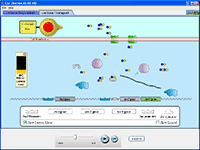 |
Build a gene network! The lac operon is a set of genes which are responsible for the metabolism of lactose in some bacterial cells. Explore the effects of mutations within the lac operon by adding or removing genes from the DNA. Details and get access to Gene Machine; The Lac Operon Check out Gene Machine; The Lac Operon |
Membrane Channels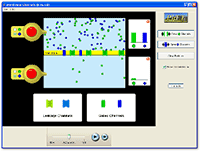 |
Insert channels in a membrane and see what happens. See how different types of channels allow particles to move through the membrane. Details and get access to Membrane Channels Check out Membrane Channels |
Natural Selection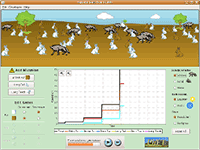 |
Explore natural selection by controlling the environment and causing mutations in bunnies. Details and get access to Natural Selection Check out Gene Machine; The Lac Operon |
Neuron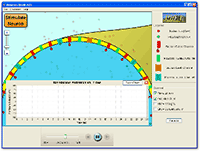 |
Stimulate a neuron and monitor what happens. Pause, rewind, and move forward in time in order to observe the ions as they move across the neuron membrane. Details and get access to Neuron Check out Natural Selection |
Stretching DNA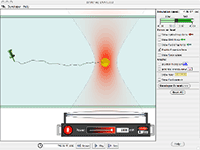 |
Explore stretching just a single strand of DNA using optical tweezers or fluid flow. Experiment with the forces involved and measure the relationship between the stretched DNA length and the force required to keep it stretched. Is DNA more like a rope or like a spring? Details and get access to Stretching DNA Check out Stretching DNA |
These are collection of lab activities developed from the Virtual Courseware Project at Cal State University-Los Angeles. The following experiments offer a series of interactive, inquiry-based biology simulations and exercises designed for college and AP high school biology students.
| Online Activity Labs: | Topics: |
|---|---|
CardioLab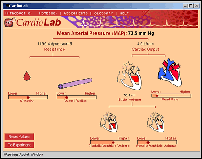 |
Students explore the concept of homeostasis using arterial blood pressure as an example. The interaction of variables related to heart rate, vessel radius, blood viscocity, and stroke volume can be studied by direct manipulation, or indirectly through interventions, such as hemorrhage, exercise, dehydration, shock, intravenous infusion, epinephrine, and foxglove. Nerve impulses can be monitored under the experimental conditions. Realistic case studies such as hypertension and congestive heart failure are also available for investigation. Details and get access to CardioLab. Check out CardioLab |
DemographyLab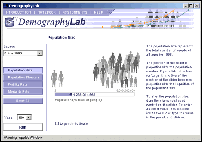 |
Students investigate how differences in population size, age-structure, and age-specific fertility and mortality rates affect human population growth. This lab can be used to investigate phenomena such as exponential growth, stable age structure, zero population growth, and demographic momentum. Details and get access to DemographyLab. Check out DemographyLab |
EnzymeLab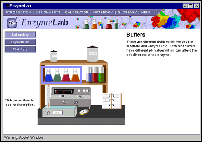 |
Students study properties of enzymatic reactions by photometrically measuring the initial rate of synthesis of a product. Enzyme principles that can be investigated with this lab are pH and temperature optimums, Michaelis-Menton constants such as Km, Ki and Vmax, and the different classes of inhibitors. Details and get access to EnzymeLab. Check out EnzymeLab |
EvolutionLab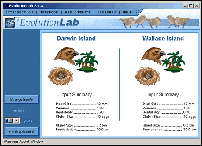 |
Students investigate the process of adaptation by natural selection by manipulating various parameters of a bird species, such as initial mean beak size, variability, heritability, and population size, and various parameters of the environment such as precipitation and island size. This lab can be used to investigate evolutionary principles such as directional, disruptive and balancing selection, the dependence of natural selection on the variability and heritability of a trait, founder effects, genetic drift, and extinction. Details and get access to EvolutionLab. Check out EvolutionLab |
FlyLab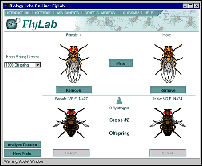 |
Students learn the principles of genetic inheritance by designing matings between female and male fruit flies carrying one or more genetic mutations. This lab can be used to demonstrate genetic principles such as dominant versus recessive traits, independent assortment, sex-linked inheritance, linkage and chromosome maps, and modifications to Mendelian ratios caused by lethal mutations and epistasis. Details and get access to FlyLab. Check out FlyLab |
HemoglobinLab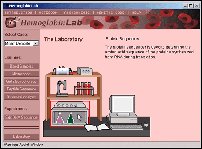 |
Students study the relationship of the structure and function of hemoglobin to the structure and function of human red blood cells. They use techniques such as gel electrophoresis, peptide sequencing, and computer modeling to study hemoglobin structure. They can investigate how mutations in hemoglobin genes affect its polypeptide sequence and relate these effects to the symptoms of individual case studies. Details and get access to HemoglobinLab. Check out HemoglobinLab |
LeafLab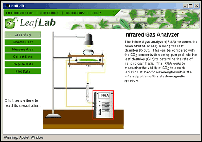 |
Students measure photosynthetic rates of leaves by carbon dioxide assimilation. They investigate how photosynthetic rates change as a function of light intensity, light quality, temperature, and ambient carbon dioxide. This lab can be used to demonstrate concepts such as dark respiration, photochemical efficiency, carbon dioxide conductance, light compensation points, photosynthetic saturation, and differences in photosynthetic rates of C-3 versus C-4 plants, sun versus shade plants, and different levels of polyploidy. Details and get access to LeafLab. Check out LeafLab |
MitochondriaLab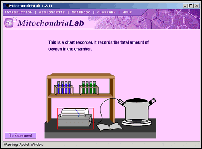 |
Students measure the oxygen consumption of mitochondrial extracts in the presence of different substrates, inhibitors, and ADP to investigate the TCA cycle, electron transport, and oxidative phosphorylation. Seven substrates and six inhibitors can be used in any order or combination by the student, providing the flexibility for a number of different experiments. Details and get access to MitochondriaLab. Check out MitochondriaLab |
PedigreeLab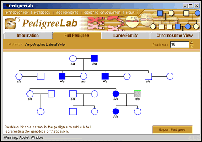 |
Students use pedigree analysis to study the inheritance of genes for human genetic disorders and RFLP analysis to study recombination in humans. Using RFLPs as genetic markers, students search a simulated pedigree database to obtain recombination data that allows them to determine the location of human genes on chromosomes. Details and get access to PedigreeLab. Check out PedigreeLab |
PopEcoLab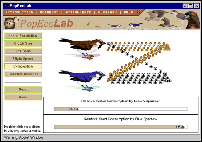 |
Students investigate principles of population ecology by manipulating various attributes of three bird species: two competing sparrows and a hawk predator. Users can vary initial population numbers, clutch size, life span, competition coefficients, predation rates and resource availability. This lab can be used to investigate ecological principles such as carrying capacity, extinction, overpopulation, competitive coexistence, competitive exclusion, predator-prey cycles, and predator-mediated coexistence. Details and get access to PopEcoLab. Check out PopEcoLab |
PopGenLab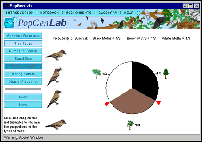 |
Students track changes in the genotype and allele frequencies in populations of moths to study population genetic principles such as Hardy-Weinberg ratios, genetic drift, natural selection, migration, assortative matiing, and population bottlenecks. Experiments can be conducted by manipulating parameters such as the initial genotype frequencies, the carrying capacity of each population, the rates of predation on the moth phenotypes, the migration rates among populations, mating preferences among phenotypes, and the frequency of population "crashes." Details and get access to PopGenLab. Check out PopGenLab |
TranslationLab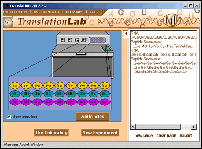 |
Students create simple RNA sequences and then translate these in a virtual "in vitro" cell-free system. From the proteins produced by the translation mix, students determine the characteristics of the genetic code and assign codons to amino acids. This lab was modeled after some of the original experiments used to determine the genetic code. Details and get access to TranslationLab. Check out TranslationLab |
| Website: | Topics: |
|---|---|
MERLOT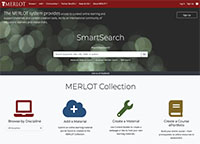 |
| Website: | Topics: |
|---|---|
Open Text BC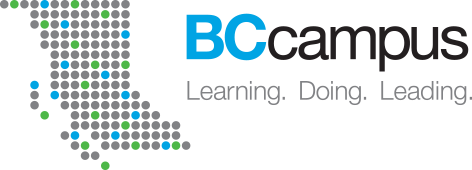 |
The BCcampus Open Education Virtual Lab and Science Resource Directory for Biology lists free biology resources designed to support remote biology education. |
| Website: | Topics: |
|---|---|
NSDL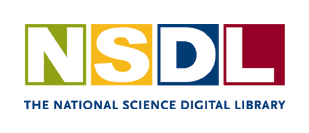 |
The National Science Digital Library - provides high quality online educational resources for teaching and learning, with current emphasis on the sciences, technology, engineering, and mathematics (STEM) disciplines–both formal and informal, institutional and individual, in local, state, national, and international educational settings. The NSDL collection contains structured descriptive information (metadata) about web-based educational resources held on other sites by their providers. These providers have contribute this metadata to NSDL for organized search and open access to educational resources via this website and its services. |
Are you using free Virtual Lab materials you found on the web in your teaching or your learning? Have you posted free Virtual Labs online that are open for others to use? We invite you to catalog these Virtual Labs you use or authored in MERLOT. Your colleagues and students around the world will thank you!
First: Become a member of MERLOT (It will take about 2 minutes and it’s FREE).
Second: Log in to MERLOT and click to Add a Material. (It will take about 4 minutes the first time and step-by-step instructions for contributing materials to MERLOT are available).